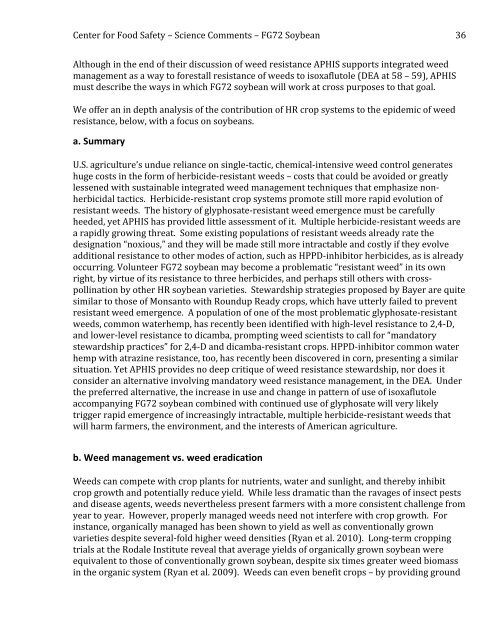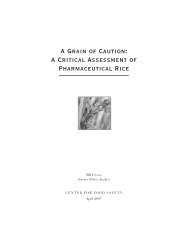a four-fold rise - Center for Food Safety
a four-fold rise - Center for Food Safety
a four-fold rise - Center for Food Safety
You also want an ePaper? Increase the reach of your titles
YUMPU automatically turns print PDFs into web optimized ePapers that Google loves.
<strong>Center</strong> <strong>for</strong> <strong>Food</strong> <strong>Safety</strong> – Science Comments – FG72 Soybean <br />
36 <br />
Although in the end of their discussion of weed resistance APHIS supports integrated weed <br />
management as a way to <strong>for</strong>estall resistance of weeds to isoxaflutole (DEA at 58 – 59), APHIS <br />
must describe the ways in which FG72 soybean will work at cross purposes to that goal. <br />
We offer an in depth analysis of the contribution of HR crop systems to the epidemic of weed <br />
resistance, below, with a focus on soybeans. <br />
a. Summary <br />
U.S. agriculture’s undue reliance on single-‐tactic, chemical-‐intensive weed control generates <br />
huge costs in the <strong>for</strong>m of herbicide-‐resistant weeds – costs that could be avoided or greatly <br />
lessened with sustainable integrated weed management techniques that emphasize non-herbicidal<br />
tactics. Herbicide-‐resistant crop systems promote still more rapid evolution of <br />
resistant weeds. The history of glyphosate-‐resistant weed emergence must be carefully <br />
heeded, yet APHIS has provided little assessment of it. Multiple herbicide-‐resistant weeds are <br />
a rapidly growing threat. Some existing populations of resistant weeds already rate the <br />
designation “noxious,” and they will be made still more intractable and costly if they evolve <br />
additional resistance to other modes of action, such as HPPD-‐inhibitor herbicides, as is already <br />
occurring. Volunteer FG72 soybean may become a problematic “resistant weed” in its own <br />
right, by virtue of its resistance to three herbicides, and perhaps still others with cross-pollination<br />
by other HR soybean varieties. Stewardship strategies proposed by Bayer are quite <br />
similar to those of Monsanto with Roundup Ready crops, which have utterly failed to prevent <br />
resistant weed emergence. A population of one of the most problematic glyphosate-‐resistant <br />
weeds, common waterhemp, has recently been identified with high-‐level resistance to 2,4-‐D, <br />
and lower-‐level resistance to dicamba, prompting weed scientists to call <strong>for</strong> “mandatory <br />
stewardship practices” <strong>for</strong> 2,4-‐D and dicamba-‐resistant crops. HPPD-‐inhibitor common water <br />
hemp with atrazine resistance, too, has recently been discovered in corn, presenting a similar <br />
situation. Yet APHIS provides no deep critique of weed resistance stewardship, nor does it <br />
consider an alternative involving mandatory weed resistance management, in the DEA. Under <br />
the preferred alternative, the increase in use and change in pattern of use of isoxaflutole <br />
accompanying FG72 soybean combined with continued use of glyphosate will very likely <br />
trigger rapid emergence of increasingly intractable, multiple herbicide-‐resistant weeds that <br />
will harm farmers, the environment, and the interests of American agriculture. <br />
b. Weed management vs. weed eradication <br />
Weeds can compete with crop plants <strong>for</strong> nutrients, water and sunlight, and thereby inhibit <br />
crop growth and potentially reduce yield. While less dramatic than the ravages of insect pests <br />
and disease agents, weeds nevertheless present farmers with a more consistent challenge from <br />
year to year. However, properly managed weeds need not interfere with crop growth. For <br />
instance, organically managed has been shown to yield as well as conventionally grown <br />
varieties despite several-‐<strong>fold</strong> higher weed densities (Ryan et al. 2010). Long-‐term cropping <br />
trials at the Rodale Institute reveal that average yields of organically grown soybean were <br />
equivalent to those of conventionally grown soybean, despite six times greater weed biomass <br />
in the organic system (Ryan et al. 2009). Weeds can even benefit crops – by providing ground







